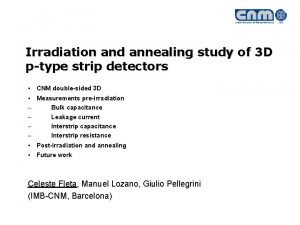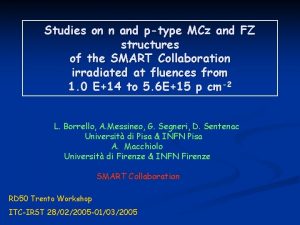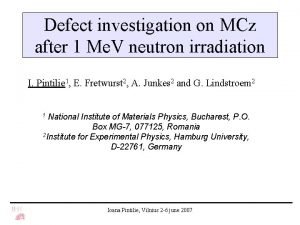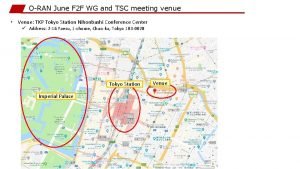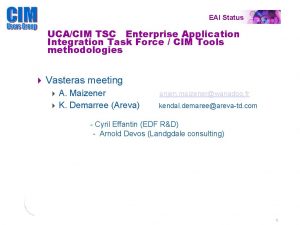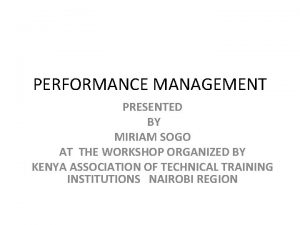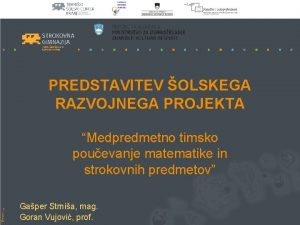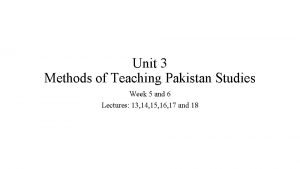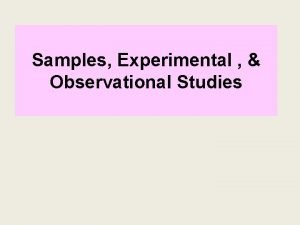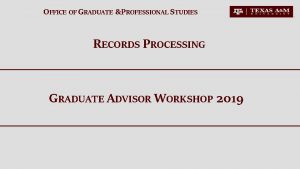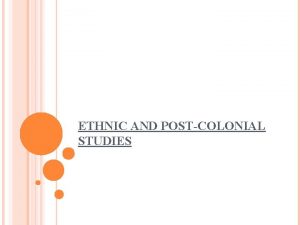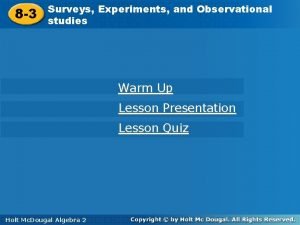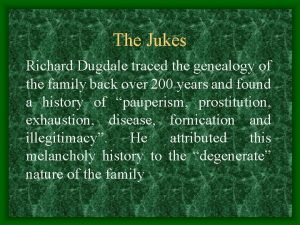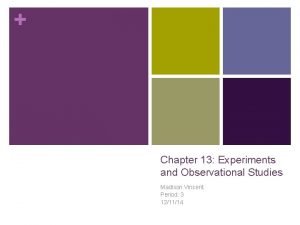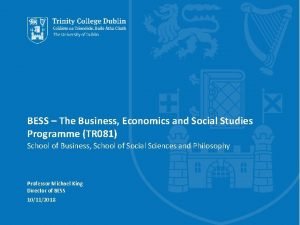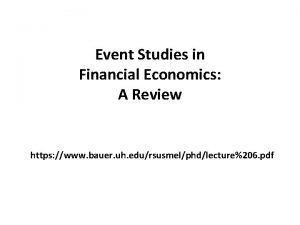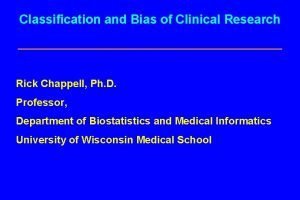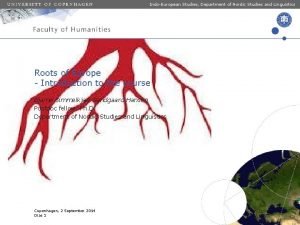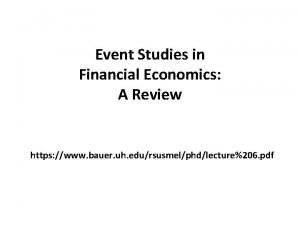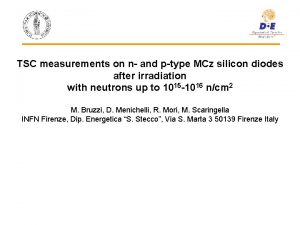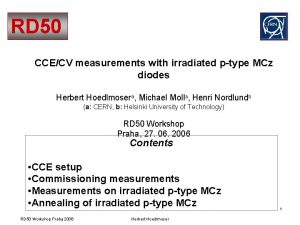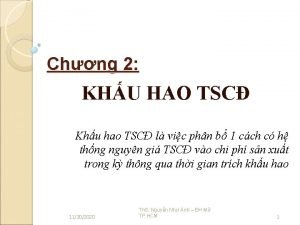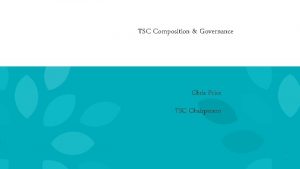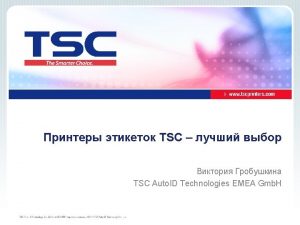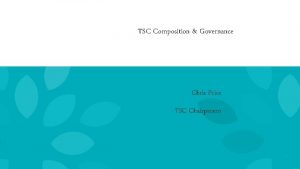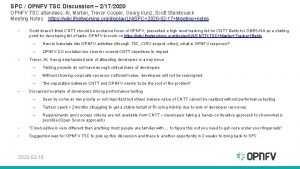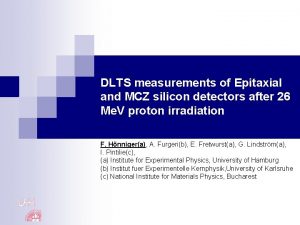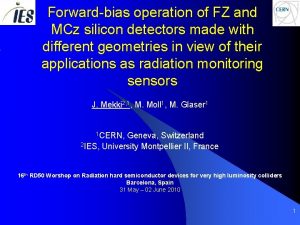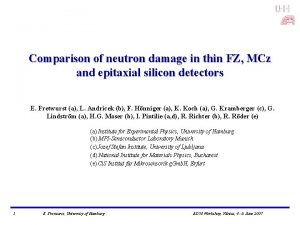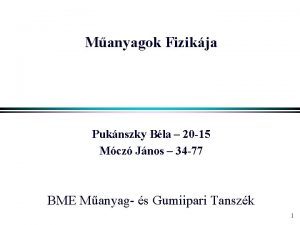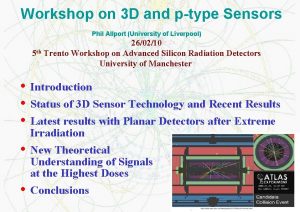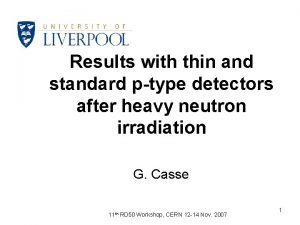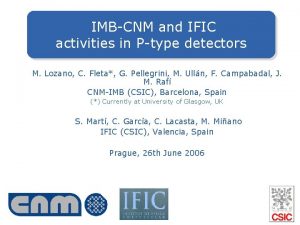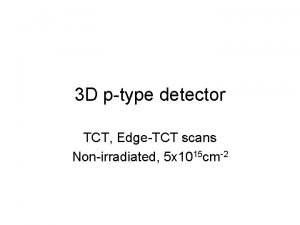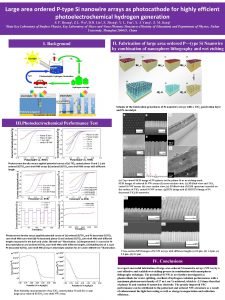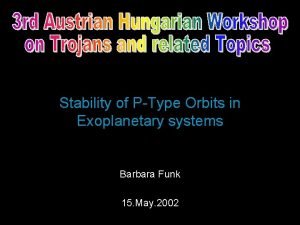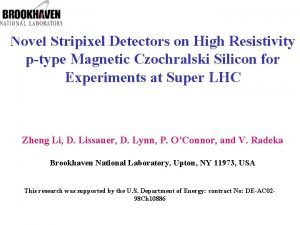TSC studies on n and ptype MCZ Si


































![TSC discontinuities • Explained as SCSIs [Menichelli et al. , APA (2006)] DOFZ M. TSC discontinuities • Explained as SCSIs [Menichelli et al. , APA (2006)] DOFZ M.](https://slidetodoc.com/presentation_image/17dc490fcf0b2ad6a6c65e7ef06815f1/image-35.jpg)
- Slides: 35

TSC studies on n- and p-type MCZ Si pad detectors irradiated with neutrons up to 1016 n/cm 2 M. Scaringella, M. Bruzzi, D. Menichelli, R. Mori INFN Firenze, Dip. Energetica “S. Stecco”, Via S. Marta 3 50139 Firenze Italy M. Scaringella, M. Bruzzi, D. Menichelli, R. Mori , TSC studies on n- and p-type MCz silicon pad detectors irradiated with neutrons up to 1016 n/cm 2 15° RD 50 workshop, 16 November - 18 November 2009, Geneva

Samples and irradiation -Material: n-type magnetic Czochralski silicon produced by Okmetic (Finland) with 900 Wcm resistivity, <100> orientation and 280 mm thickness. -Devices: p-on-n planar diodes 0. 5 x 0. 5 cm 2 -Procurement: WODEAN, Thanks to E. Fretwurst, G. Lindstroem -Irradiation: reactor neutrons at the Jozef Stefan Institute, Ljubljana -Fluence: 1014 -1015 neq/cm 2 1 Me. V equivalent neutron -Annealing: 1 year room temperature -Material: p-type magnetic Czochralski silicon produced by Okmetic (Finland) with 2 k Wcm resistivity, <100> orientation and 280 mm thickness -devices: n-on-p square diodes 0. 5 x 0. 5 cm 2 -Procurement: SMART, Thanks to D. Creanza, N. Pacifico -Irradiation: reactor neutrons at the Jozef Stefan Institute, Ljubljana -Fluence: 1014 -1016 1/cm 2 1 Me. V equivalent neutron -Annealing: few days room temperature (+ 80 min 80°C) M. Scaringella, M. Bruzzi, D. Menichelli, R. Mori , TSC studies on n- and p-type MCz silicon pad detectors irradiated with neutrons up to 1016 n/cm 2 15° RD 50 workshop, 16 November - 18 November 2009, Geneva

Measurement Techniques 1. Thermally Stimulated Currents with cryogenic equipments: measurements performed on liquid He vapors, to ensure stable temperatures down to 4. 2 K minimize thermal inertia and mismatch. 2. Zero Bias Thermally Stimulated Currents measured at high fluence in the high temperature range (100 -200 K), to avoid background current subtraction, and increase resolution in deep levels analysis. Used in all T range to study the residual electric field due to charged defects. Aims: (a) Optimize the priming procedure to evidence radiation induced defects and correctly evaluate their concentration; (b) Get information about electric field distribution. M. Scaringella, M. Bruzzi, D. Menichelli, R. Mori , TSC studies on n- and p-type MCz silicon pad detectors irradiated with neutrons up to 1016 n/cm 2 15° RD 50 workshop, 16 November - 18 November 2009, Geneva

TSC and ZB-TSC (→ same as TSC but Vbias = 0 ) The method: procedure and symbols T Common procedures: Ti cooling V Vfill Vbias priming heating Current priming -Cooling with applied reverse Vcool or null bias time -Forward voltage applied Vfill at Ti -TSC with Vbias or null bias (ZB-TSC) time Optical priming -illumination with optical source and Vfill at Ti -TSC with Vbias or null bias (ZB-TSC) Vcool Ifill time TSC peak M. Scaringella, M. Bruzzi, D. Menichelli, R. Mori , TSC studies on n- and p-type MCz silicon pad detectors irradiated with neutrons up to 1016 n/cm 2 15° RD 50 workshop, 16 November - 18 November 2009, Geneva

ZBTSC: More on the Experimental procedure 1. Priming provide an injection of carriers which are trapped at energy levels, according to an asymmetrical distribution induced by external polarization (Vbias). 2. At low temperature electrodes are shortcircuited: the carriers at electrodes and in bulk redistribute themselves in order to establish zero voltage and zero field boundary conditions. Charge frozen at low temperature → non-uniform electric field and non-monotonous potential distribution with minima and maxima corresponding to zero electric-field planes settle. p+ n+ D e. Fp e. Vrev e. Fn A Neff > 0 Neff < 0 + p n+ D e. Fp= e. Fn d. V = 0 dx A Zero-field planes Example: double junction in irradiated p-on-n Si ( voltages measured at n+ respect to p+). Charge distribution not shown. 3. ZBTSC scan (heating): system brought back to the fundamental equilibrium state. Charge redistribute into the volume and charge injection occurs at the electrodes, giving rise to current detected in the external circuit. Charge relaxation during heating scan be discussed in terms of motion of the zero electric-field planes along the sample thickness. M. Scaringella, M. Bruzzi, D. Menichelli, R. Mori , TSC studies on n- and p-type MCz silicon pad detectors irradiated with neutrons up to 1016 n/cm 2 15° RD 50 workshop, 16 November - 18 November 2009, Geneva

Problems ancountered in TSC after priming Normally the peak height increases with increasing bias voltage Scaringella et al. Nucl. Instrum Meth A 570 (2007) 322– 329 In some case it decreases TSC peak saturation does not correspond to full volume emission Bruzzi et al. J. Appl. Phys. 99 (2006) 093706 M. Scaringella, M. Bruzzi, D. Menichelli, R. Mori , TSC studies on n- and p-type MCz silicon pad detectors irradiated with neutrons up to 1016 n/cm 2 15° RD 50 workshop, 16 November - 18 November 2009, Geneva

Experimental results obtained with different TSC and ZB-TSC parameters Ifill, Vcool, Vbias A - Forward current priming n-on-p F=1015 neq/cm 2 annealed 80 min @80°C With same Vcool and Vbias TSC peaks height always increases with the filling current. Increasing Ifill more charges are trapped at defects, so TSC and ZB-TSC emission is higher M. Scaringella, M. Bruzzi, D. Menichelli, R. Mori , TSC studies on n- and p-type MCz silicon pad detectors irradiated with neutrons up to 1016 n/cm 2 15° RD 50 workshop, 16 November - 18 November 2009, Geneva

ZB-TSC peaks height increases with increasing Vcool ( zero Vbias and Ifill) Cooling under reverse bias build-up a residual field (opposite to the cooling voltage), due to the charges frozen in the radiation induced traps. This field increases with Vcool and it drives the first emission of charge during the ZB-TSC. M. Scaringella, M. Bruzzi, D. Menichelli, R. Mori , TSC studies on n- and p-type MCz silicon pad detectors irradiated with neutrons up to 1016 n/cm 2 15° RD 50 workshop, 16 November - 18 November 2009, Geneva

When applying Ifill 1) Ifill decrease when |Vcool| increase 2) ZB-TSC peak height mainly determined by Ifill (altough higher residual field because higher |Vcool|) I [p. A] M. Scaringella, M. Bruzzi, D. Menichelli, R. Mori , TSC studies on n- and p-type MCz silicon pad detectors irradiated with neutrons up to 1016 n/cm 2 15° RD 50 workshop, 16 November - 18 November 2009, Geneva

B - Optical priming ( l= 850 nm ) Dependence of TSC peak heights on bias voltage applied during illumination (Vfill) Reverse voltage gives lower TSC and higher ZB-TSC with respect to forward voltage M. Scaringella, M. Bruzzi, D. Menichelli, R. Mori , TSC studies on n- and p-type MCz silicon pad detectors irradiated with neutrons up to 1016 n/cm 2 15° RD 50 workshop, 16 November - 18 November 2009, Geneva

Comparison between forward current and optical priming In heavily irradiated samples optical priming can be much more efficient than forward current priming M. Scaringella, M. Bruzzi, D. Menichelli, R. Mori , TSC studies on n- and p-type MCz silicon pad detectors irradiated with neutrons up to 1016 n/cm 2 15° RD 50 workshop, 16 November - 18 November 2009, Geneva

Effects of the residual field in a TSC 1) Optical filling with reverse bias (Vfill =+100 V): evidence of residual field setup. TSC discontinuity reflects the residual field in the bulk. It’s the same residual field that drives the ZB-TSC! M. Scaringella, M. Bruzzi, D. Menichelli, R. Mori , TSC studies on n- and p-type MCz silicon pad detectors irradiated with neutrons up to 1016 n/cm 2 15° RD 50 workshop, 16 November - 18 November 2009, Geneva

2) The intensity of the current from the residual electric field can be higher than the one observed in a standard TSC M. Scaringella, M. Bruzzi, D. Menichelli, R. Mori , TSC studies on n- and p-type MCz silicon pad detectors irradiated with neutrons up to 1016 n/cm 2 15° RD 50 workshop, 16 November - 18 November 2009, Geneva

3) Forward current priming, TSC with Vbias < Vcool. Residual field can be so high to give evidence of an opposite current in a TSC! “Against the tide” M. Scaringella, M. Bruzzi, D. Menichelli, R. Mori , TSC studies on n- and p-type MCz silicon pad detectors irradiated with neutrons up to 1016 n/cm 2 15° RD 50 workshop, 16 November - 18 November 2009, Geneva

Discussion: explain results with a band diagram model A -Forward current priming FROZEN CHARGE DISTRIBUTION (0 bias) COOLING (reverse bias) n+ e n+ p p+ e. C e. Fp DA, e. Fn e·Vcool l 1 V nn pn + ZFP 1 E e n p+ e. V (e-)-trap C n, p - e. F DD, (h)-trap e e p ZFP 2 l 2 bulk FORWARD FILLING p pp np Free carriers during reverse bias n+ e p J e. C e. V p+ e. Fp e. Fn + e·Vfill M. Scaringella, M. Bruzzi, D. Menichelli, R. Mori , TSC studies on n- and p-type MCz silicon pad detectors irradiated with neutrons up to 1016 n/cm 2 15° RD 50 workshop, 16 November - 18 November 2009, Geneva

B-OPTICAL PRIMING OPTICAL EXCITATION (reverse bias) e n+ p 1 (hn) 2 e. C DA, e. Fp (e-)-trap p+ n+ DD, (h)-trap e·Vfill e. Fn 2 nn pn e. F p e e. C - p+ + e. V n, p metastable condition afterwards p n p(bias) n(opt)p(opt) E ZFP 1 ZFP 2 pp np Ebulk=Eres≠ 0 - n(opt), p(opt): ALMOST UNIFORM -n(bias), p(bias): ASYMMETRIC => n, p: ASYMMETRIC - Residual field present - Only a portion of the volume is filled M. Scaringella, M. Bruzzi, D. Menichelli, R. Mori , TSC studies on n- and p-type MCz silicon pad detectors irradiated with neutrons up to 1016 n/cm 2 15° RD 50 workshop, 16 November - 18 November 2009, Geneva

OPTICAL EXCITATION (forward bias) (hn) n+ e. C nn pn p n+ p+ p e 2 1 e. Fn n n(bias) p+ e e. Fp e. V n, p metastable condition afterwards p p(bias) n(opt) p(opt) e·Vfill e. F e. C e. V 2 pp np -n(opt), p(opt), n(bias), p(bias): ALMOST UNIFORM => n, p: SYMMETRIC E Ebulk=Eres→ 0 - Residual field very low - Almost uniform priming M. Scaringella, M. Bruzzi, D. Menichelli, R. Mori , TSC studies on n- and p-type MCz silicon pad detectors irradiated with neutrons up to 1016 n/cm 2 15° RD 50 workshop, 16 November - 18 November 2009, Geneva

Observations about current sign in ZBTSC Usually the sign of the ZB-TSC is opposite to the TSC, under the same priming conditions In some cases the sign is the same M. Scaringella, M. Bruzzi, D. Menichelli, R. Mori , TSC studies on n- and p-type MCz silicon pad detectors irradiated with neutrons up to 1016 n/cm 2 15° RD 50 workshop, 16 November - 18 November 2009, Geneva

EMISSION TSC n+ p ZBTSC p+ e p n+ e e. F e. C e. V E e·Vbias J>0 e. C p+ 2 1 + (J<0) e. V ZFP 1 ZFP 2 E The sign of the current depends on the dominating emission mechanism M. Scaringella, M. Bruzzi, D. Menichelli, R. Mori , TSC studies on n- and p-type MCz silicon pad detectors irradiated with neutrons up to 1016 n/cm 2 15° RD 50 workshop, 16 November - 18 November 2009, Geneva

ZERO-FIELD PLANES xi(t) Position of the zero field plane (ZFP) If field induced current dominates REF: Gross B. and M. M. Perlman, J. Appl. Phys. , Vol. 43, No. 3, March 1972 The sign of the current is determined by: • The sign of the charge density at the ZFP • The motion direction of the ZFP M. Scaringella, M. Bruzzi, D. Menichelli, R. Mori , TSC studies on n- and p-type MCz silicon pad detectors irradiated with neutrons up to 1016 n/cm 2 15° RD 50 workshop, 16 November - 18 November 2009, Geneva

Possible mechanisms for electron emission in p-type Neff s 1 l 2 l 1 d s 2 x -NA- e e. C e. V ND+ Case 1 2 1 Case 2 + J(meas)>0 ZFP 1 ZFP 2 a , if b , if E M. Scaringella, M. Bruzzi, D. Menichelli, R. Mori , TSC studies on n- and p-type MCz silicon pad detectors irradiated with neutrons up to 1016 n/cm 2 15° RD 50 workshop, 16 November - 18 November 2009, Geneva

Recombination inside the bulk and NAl 1>NDl 2 Recombination outside the bulk or Recombination inside and NAl 1<NDl 2 M. Scaringella, M. Bruzzi, D. Menichelli, R. Mori , TSC studies on n- and p-type MCz silicon pad detectors irradiated with neutrons up to 1016 n/cm 2 15° RD 50 workshop, 16 November - 18 November 2009, Geneva

Summary We studied both p- and n-type MCz Si pad detectors after irradiation with reactor neutrons up to 1015 -1016 cm-2. -TSC and ZB-TSC were carried out to inspect radiation-induced defects. -Priming procedures were investigated to optimize the visualization of traps by TSC and to evidence the electric field distribution within the irradiated device. Best priming process found is optical priming in forward polarization (to be checked without polarization). -The various features observed experimentally by changing the operative parameters are qualitatively described by band diagrams. Best description accounts for the presence of a residual electric field (polarization of the irradiated Si bulk) due to frozen charged traps in the bulk and barriers close to the electrodes. Residual electric field in the bulk can be so high, in highly irradiated device, to dominate the current emission both in TSC and ZB-TSC. -The sign of the ZB-TSC current is discussed in terms of possible emission mechanisms. In most practical cases the residual field, revealed by the ZB-TSC, is opposed to the external bias voltage in a TSC scan. M. Scaringella, M. Bruzzi, D. Menichelli, R. Mori , TSC studies on n- and p-type MCz silicon pad detectors irradiated with neutrons up to 1016 n/cm 2 15° RD 50 workshop, 16 November - 18 November 2009, Geneva

spares M. Scaringella, M. Bruzzi, D. Menichelli, R. Mori , TSC studies on n- and p-type MCz silicon pad detectors irradiated with neutrons up to 1016 n/cm 2 15° RD 50 workshop, 16 November - 18 November 2009, Geneva

TSC vs. ZB-TSC Example: double junction in irradiated p-on-n Si (Voltages measured at n+ respect to p+, currents positive when flowing from n+ to p+) ; X hole trap Y electron trap. TSC ZB-TSC Sample reverse-biased: electric field always with same sign. As a consequence, emitted electrons and holes, regardless of the region from which they are emitted, produce a positive current. Electric field changes sign inside the bulk. Traps emitting close to p+ or n+ interfaces give rise to a positive current; those emitting in the bulk will produce a negative current. These two contributions, whose intensity is related to electric field rearrangement during emission, are summed up in the overall measured current. Current sign depends on which components dominate.

Electric field contributions in ZBTSC: a) built-in at electrodes; b) intrinsic at traps ionized in the bulk; c) offset due to faible potential differences remaining at electrodes during short-circuit. d) Intentional offset applied to counteract or support emission (quasi. ZBTSC). Best conditions to observe trap emission must be determined experimentally, by evaluating these components and evaluate their effect on trap emission. M. Scaringella, M. Bruzzi, D. Menichelli, R. Mori , TSC studies on n- and p-type MCz silicon pad detectors irradiated with neutrons up to 1016 n/cm 2 15° RD 50 workshop, 16 November - 18 November 2009, Geneva

Typically, but non-necessarily, the ZBTSC will flow in the opposite direction of the current that has established the charge distribution during the priming, but the initial direction can be reversed during thermal scan. Here signal due to trap emission change sign when changing from TSC to ZBTSC, while current background, due to offset voltage, is always positive. M. Scaringella, M. Bruzzi, D. Menichelli, R. Mori , TSC studies on n- and p-type MCz silicon pad detectors irradiated with neutrons up to 1016 n/cm 2 15° RD 50 workshop, 16 November - 18 November 2009, Geneva

Offset effect on current M. Scaringella, M. Bruzzi, D. Menichelli, R. Mori , TSC studies on n- and p-type MCz silicon pad detectors irradiated with neutrons up to 1016 n/cm 2 15° RD 50 workshop, 16 November - 18 November 2009, Geneva

Advantages of ZB-TSC In our n-on-p samples: 1013 n/cm 2 1014 n/cm 2 1015 n/cm 2 Tmax ~ 195 K Tmax ~ 185 K Tmax ~ 150 K Deep levels with activation energies close to midgap, important because are believed to be related to extended defects, give TSC signal in the range 180 -220 K → No reliable evidence for such defects, usually with energies >0. 4 e. V, at high fluences. M. Scaringella, M. Bruzzi, D. Menichelli, R. Mori , TSC studies on n- and p-type MCz silicon pad detectors irradiated with neutrons up to 1016 n/cm 2 15° RD 50 workshop, 16 November - 18 November 2009, Geneva

2. Inspection of intrinsic electric field due to charged defects n-on-p irradiated Si ZB-TSC measurements performed at different fluences. Thick lines indicate measurements carried out in the following reference conditions: V=Vcool=100 V during the cooling from room temperature to T 0, V=Vfill=-100 V to inject carriers at T 0. At the lowest fluence a positive signal is observed in the range 130 -160 K. At the intermediate fluence the signal extends up to 190 K and its zero-crossings reveal the presence of regions with opposite electric field. At the highest fluence the spectrum is completely dominated by negative components from the bulk. M. Scaringella, M. Bruzzi, D. Menichelli, R. Mori , TSC studies on n- and p-type MCz silicon pad detectors irradiated with neutrons up to 1016 n/cm 2 15° RD 50 workshop, 16 November - 18 November 2009, Geneva

Priming according to an asymmetrical distribution • Filling of deep levels accordingly to the free carrier distribution settled in reverse biased sample [Eremin et al. , NIMA A 476 (2002)] M. Scaringella, M. Bruzzi, D. Menichelli, R. Mori , TSC studies on n- and p-type MCz silicon pad detectors irradiated with neutrons up to 1016 n/cm 2 15° RD 50 workshop, 16 November - 18 November 2009, Geneva

Summary of relations regarding the dependences on priming parameters • Forward current priming: 1. TSC amplitude increase with filling current 2. Residual electric field increase with cooling voltage 3. Filling current decrease with cooling voltage increase • Optical priming: 1. Reverse filling polarization lower effective than forward • Optical vs. forward current: 1. Optical priming more effective than forward current priming M. Scaringella, M. Bruzzi, D. Menichelli, R. Mori , TSC studies on n- and p-type MCz silicon pad detectors irradiated with neutrons up to 1016 n/cm 2 15° RD 50 workshop, 16 November - 18 November 2009, Geneva

Other dependences Increasing fluence, Ifill after reverse cooling decrease Increasing annealing, Ifill after reverse cooling increase M. Scaringella, M. Bruzzi, D. Menichelli, R. Mori , TSC studies on n- and p-type MCz silicon pad detectors irradiated with neutrons up to 1016 n/cm 2 15° RD 50 workshop, 16 November - 18 November 2009, Geneva

SD 30 K M. Scaringella, M. Bruzzi, D. Menichelli, R. Mori , TSC studies on n- and p-type MCz silicon pad detectors irradiated with neutrons up to 1016 n/cm 2 15° RD 50 workshop, 16 November - 18 November 2009, Geneva
![TSC discontinuities Explained as SCSIs Menichelli et al APA 2006 DOFZ M TSC discontinuities • Explained as SCSIs [Menichelli et al. , APA (2006)] DOFZ M.](https://slidetodoc.com/presentation_image/17dc490fcf0b2ad6a6c65e7ef06815f1/image-35.jpg)
TSC discontinuities • Explained as SCSIs [Menichelli et al. , APA (2006)] DOFZ M. Scaringella, M. Bruzzi, D. Menichelli, R. Mori , TSC studies on n- and p-type MCz silicon pad detectors irradiated with neutrons up to 1016 n/cm 2 15° RD 50 workshop, 16 November - 18 November 2009, Geneva
 Ptype
Ptype Mcz wafers
Mcz wafers Mcz wafers
Mcz wafers Usu tsc
Usu tsc June f
June f Tsc enterprise
Tsc enterprise Vw tsc
Vw tsc Tcs food
Tcs food Tsc performance contract
Tsc performance contract Tšc kranj
Tšc kranj Paradigm shift from women studies to gender studies
Paradigm shift from women studies to gender studies Vce english study design 2023
Vce english study design 2023 Moral social and cultural studies grade 9
Moral social and cultural studies grade 9 Unit and textbook method for teaching pakistan studies
Unit and textbook method for teaching pakistan studies Biased and unbiased samples
Biased and unbiased samples Office of graduate and professional studies
Office of graduate and professional studies Example of outbreak
Example of outbreak Significant vs important
Significant vs important Ethnicity in postcolonial literature
Ethnicity in postcolonial literature Jakobson equivalence
Jakobson equivalence Surveys experiments and observational studies 8-3 answers
Surveys experiments and observational studies 8-3 answers Black studies and the racial mountain
Black studies and the racial mountain The jukes and kallikaks families studies
The jukes and kallikaks families studies Chapter 13 experiments and observational studies
Chapter 13 experiments and observational studies Center for community inclusion and disability studies
Center for community inclusion and disability studies Tcd bess
Tcd bess Nycdoe social studies scope and sequence
Nycdoe social studies scope and sequence Presentation and data response definition
Presentation and data response definition Integrating science and social studies
Integrating science and social studies What is social studies and why is it important
What is social studies and why is it important Event studies in economics and finance
Event studies in economics and finance Retrospective studies pros and cons
Retrospective studies pros and cons Advantages and disadvantages of observational studies
Advantages and disadvantages of observational studies What is social studies and why is it important
What is social studies and why is it important European and nordic studies
European and nordic studies Event studies in economics and finance
Event studies in economics and finance
